Abstract
1. Optokinetic nystagmus has been evoked from two cats using horizontally moving vertical grating patterns with sinusoidally modulated wave forms (mean luminance 8.5 cd/m2). Eye movements were recorded by DC electro-oculography. 2. The velocity 'tuning' of the slow phase response was measured for high-contrast (0.8) gratings with spatial frequencies ranging from 0.18 to 2.8 cycles/deg. Irrespective of spatial frequency, the gain of slow phase tracking always declined as the stimulus velocity exceeded 5-8 deg/sec. 3. The effect of variations in grating contrast on the gain of slow phase tracking was investigated for spatial frequencies ranging from 0.04 to 2.8 cycles/deg. These gratings always moved at a velocity of 3 deg/sec. Reductions in grating contrast produced a fall in the gain of slow phase tracking. At any given contrast, the extent of the fall in gain depended on spatial frequency. At no value of spatial frequency was an optokinetic response demonstrable when the contrast fell below 0.02. 4. The above results have been used to derive the threshold contrast for evoking an optokinetic response at each spatial frequency tested. A contrast sensitivity function is plotted from these threshold contrasts, and this is compared with previous estimates of the cat's contrast sensitivity function derived from measurements of visual discrimination and cortical evoked potentials.
Full text
PDF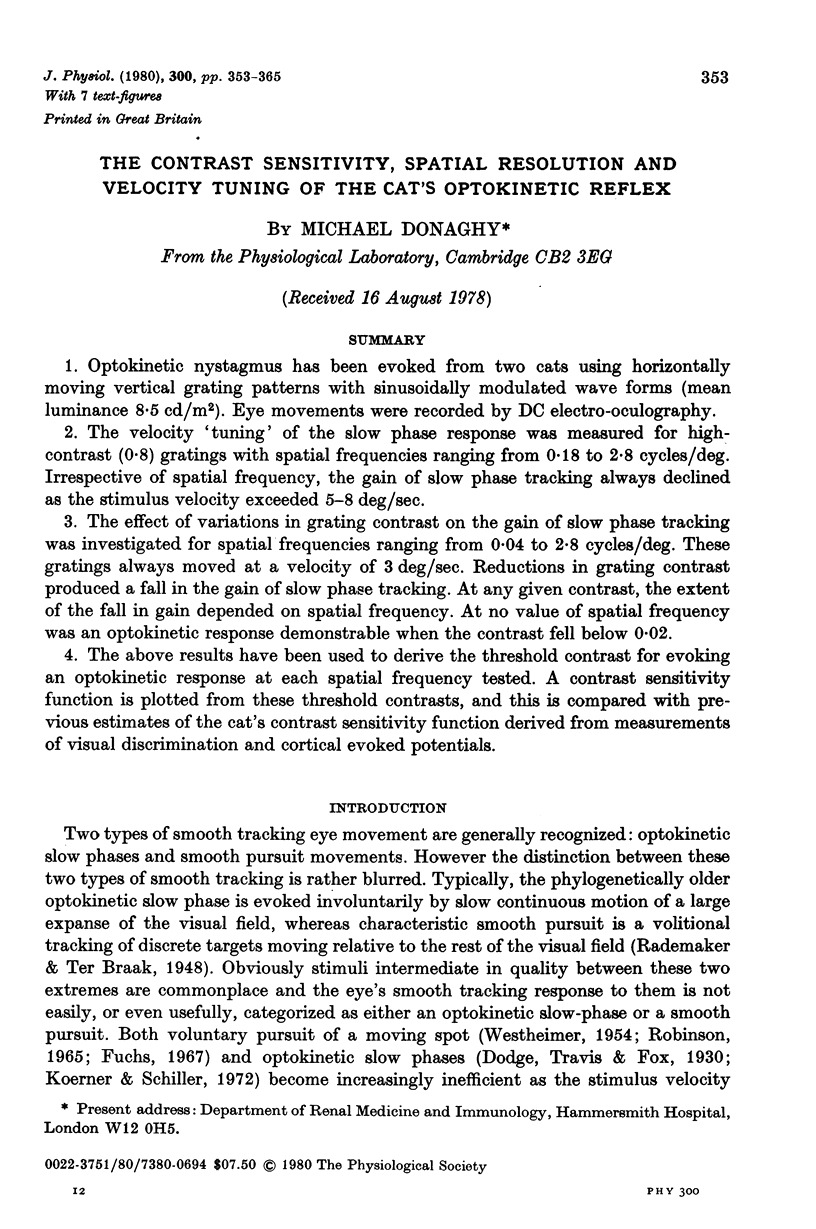
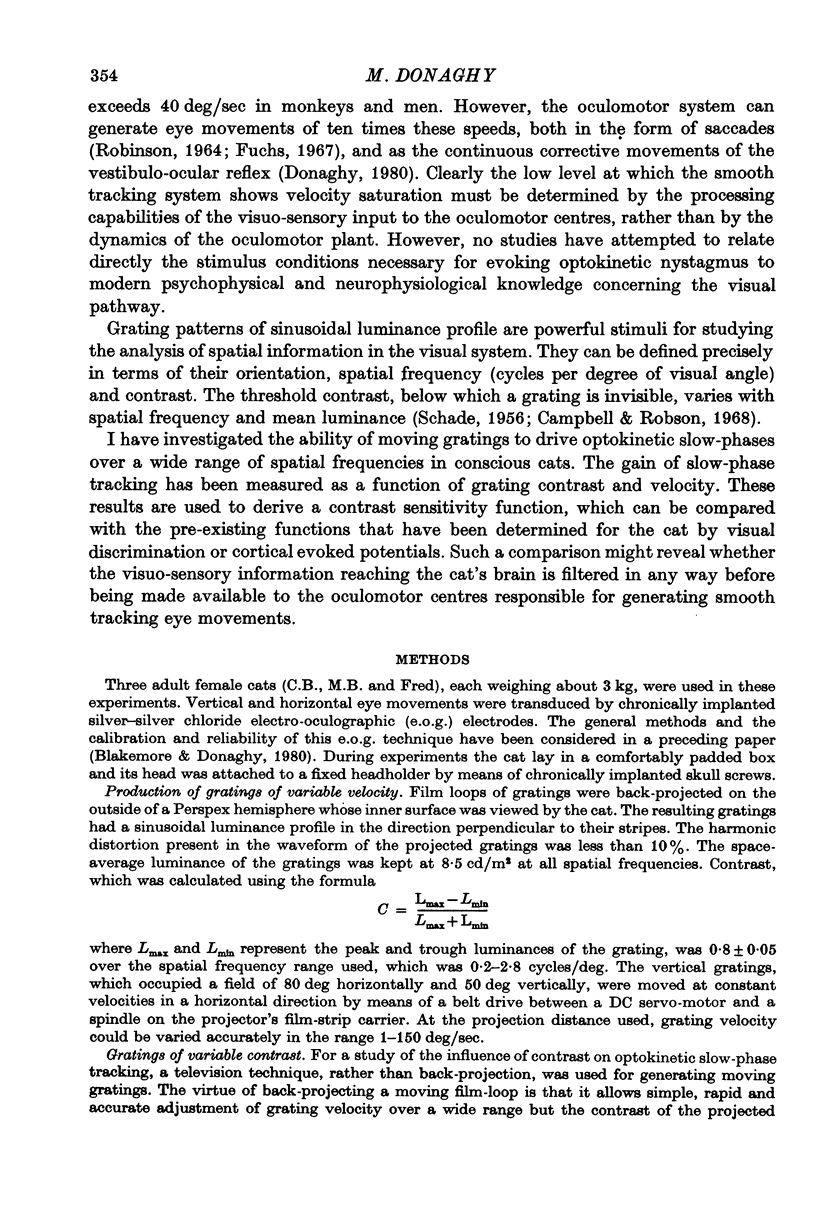
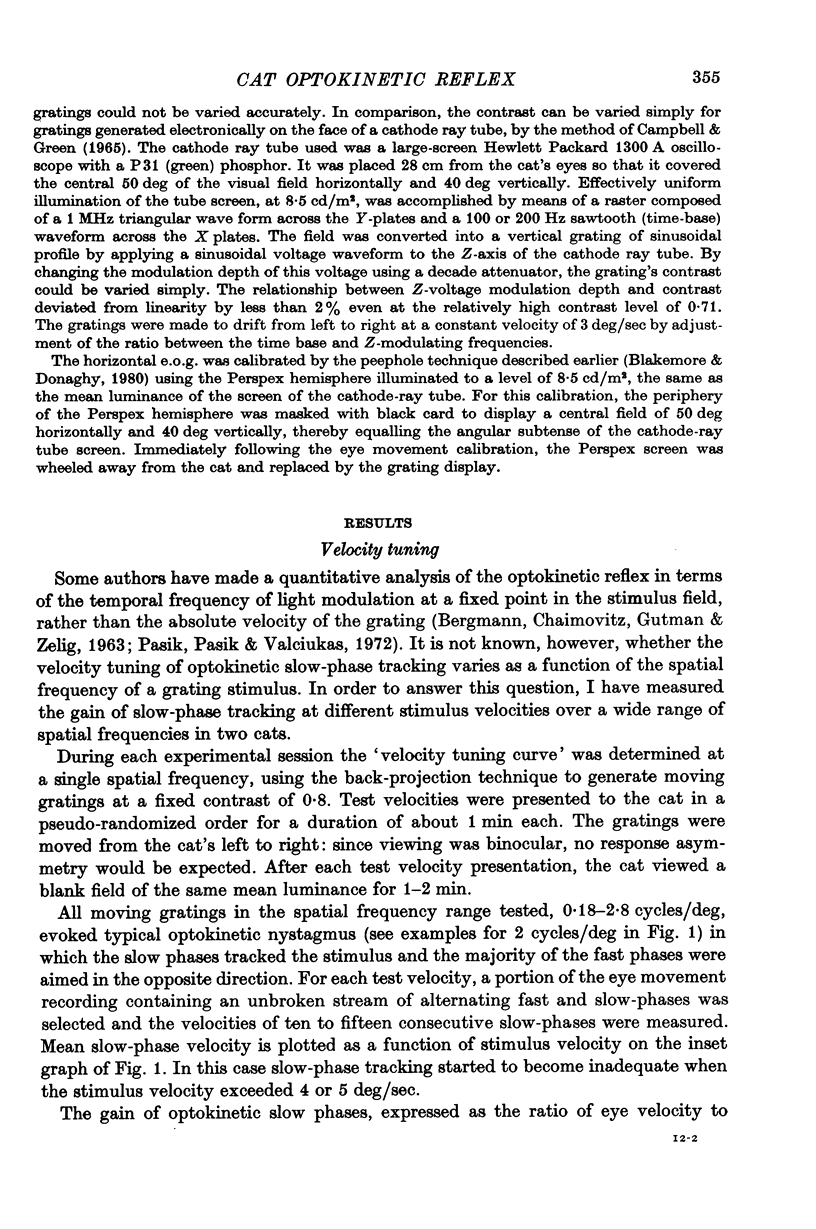
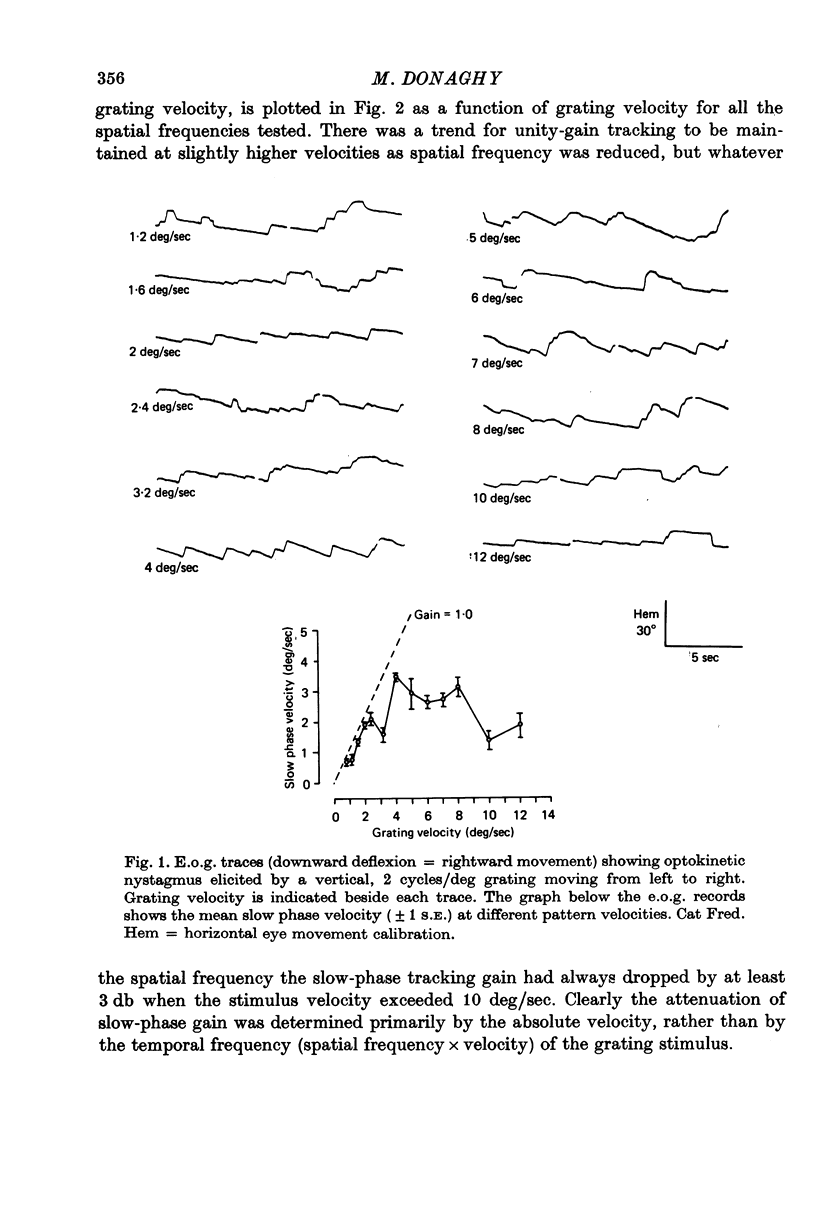

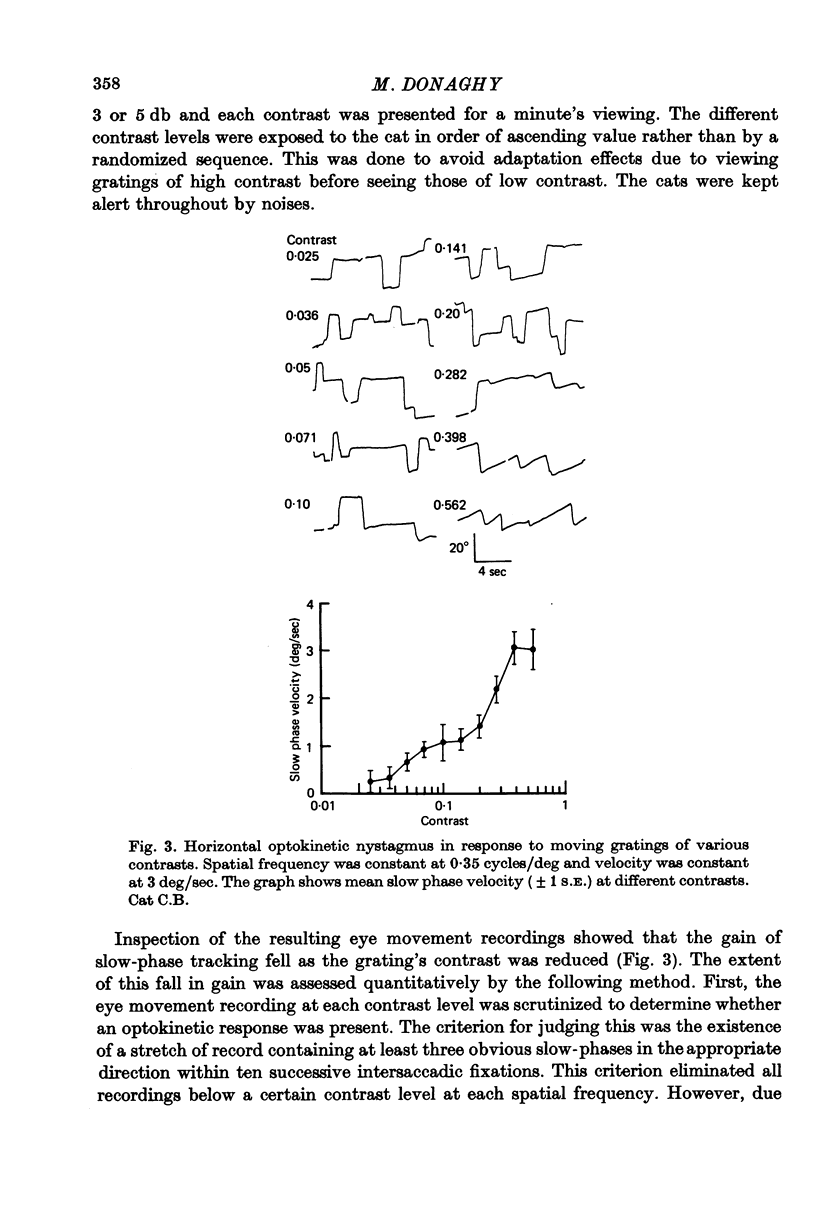
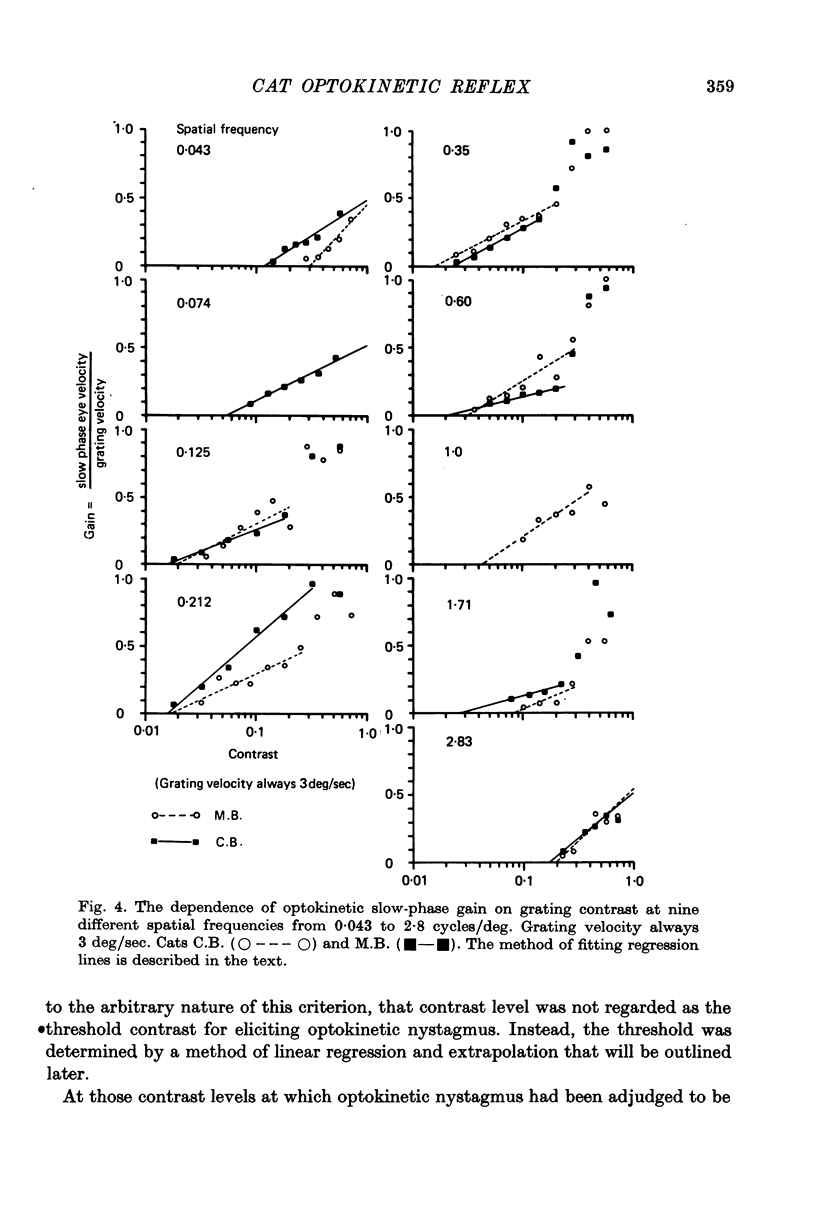
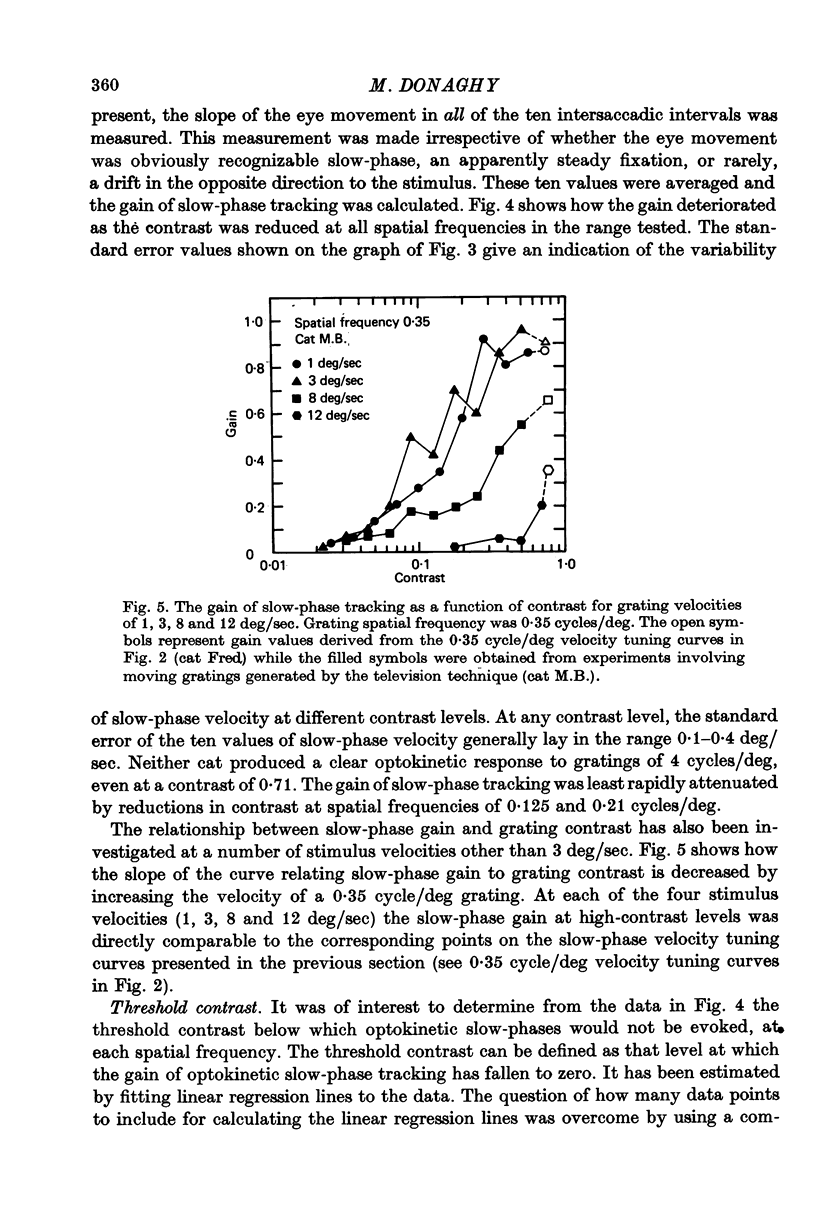

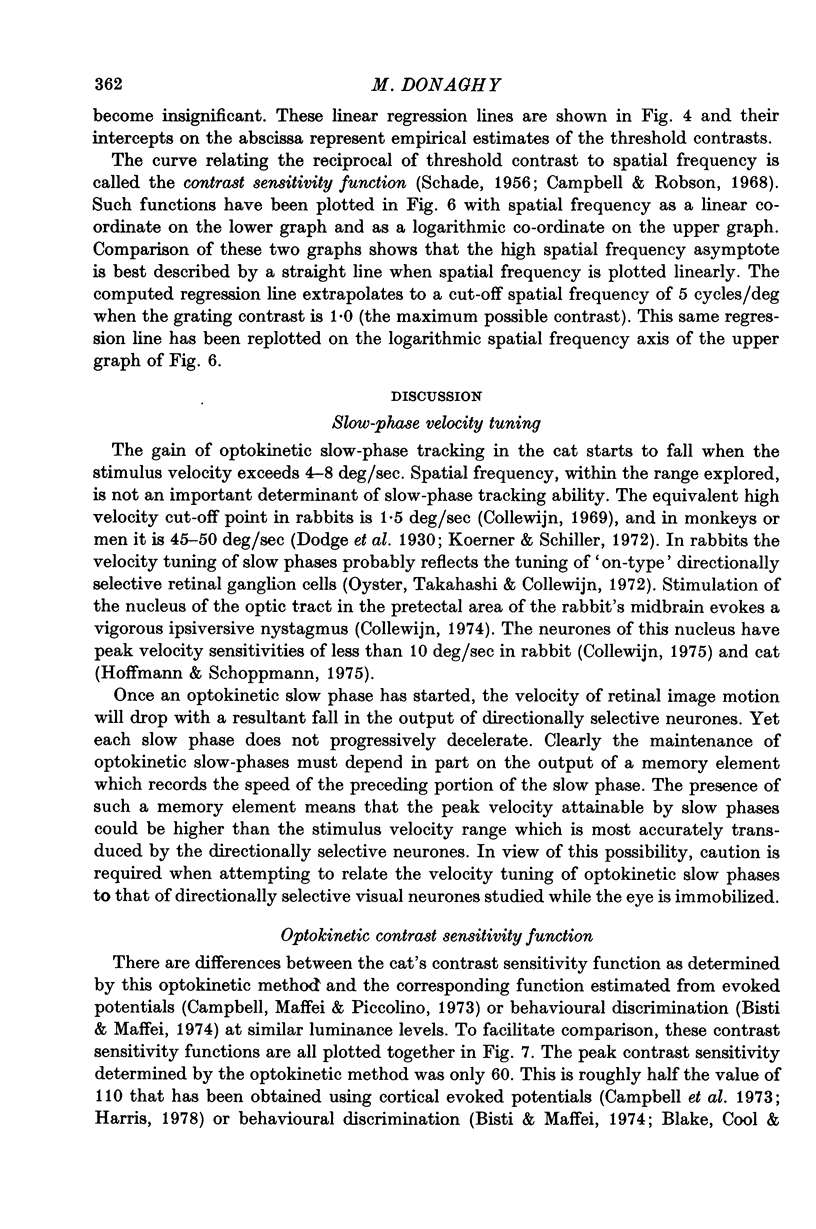
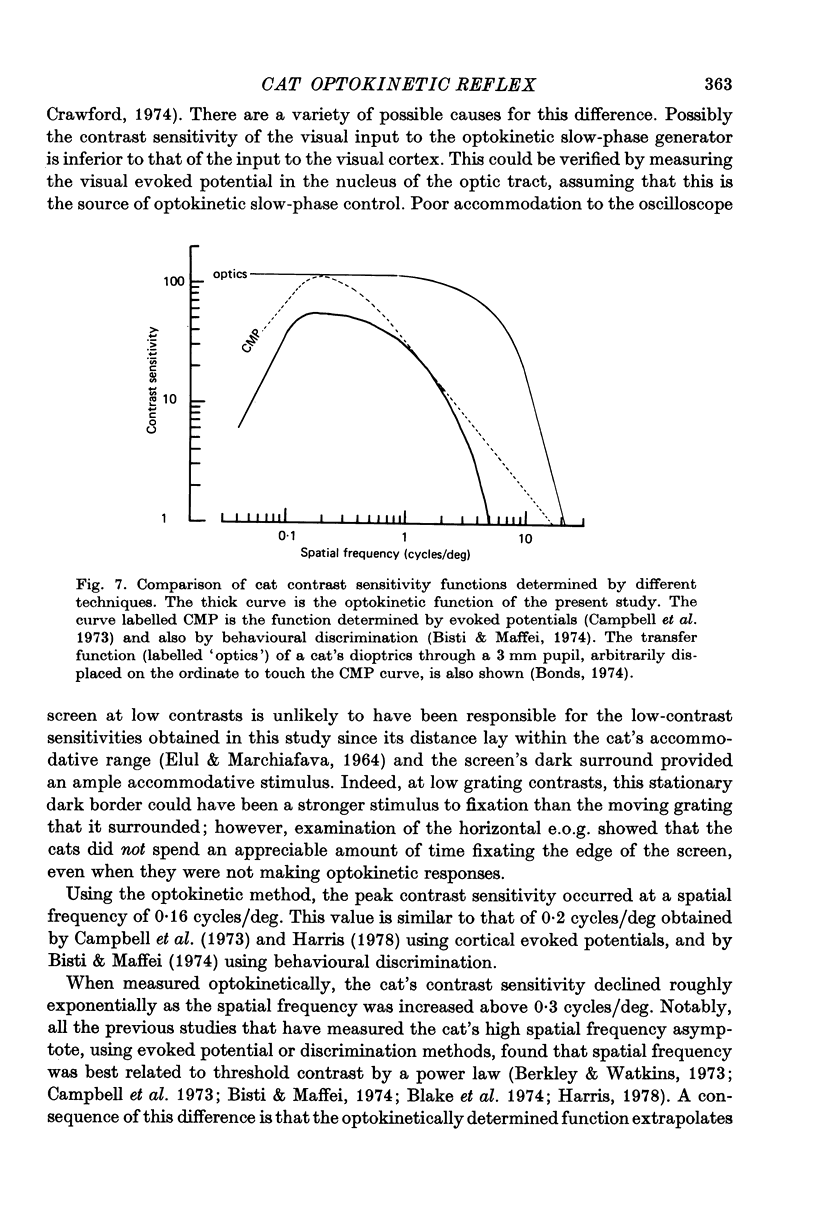
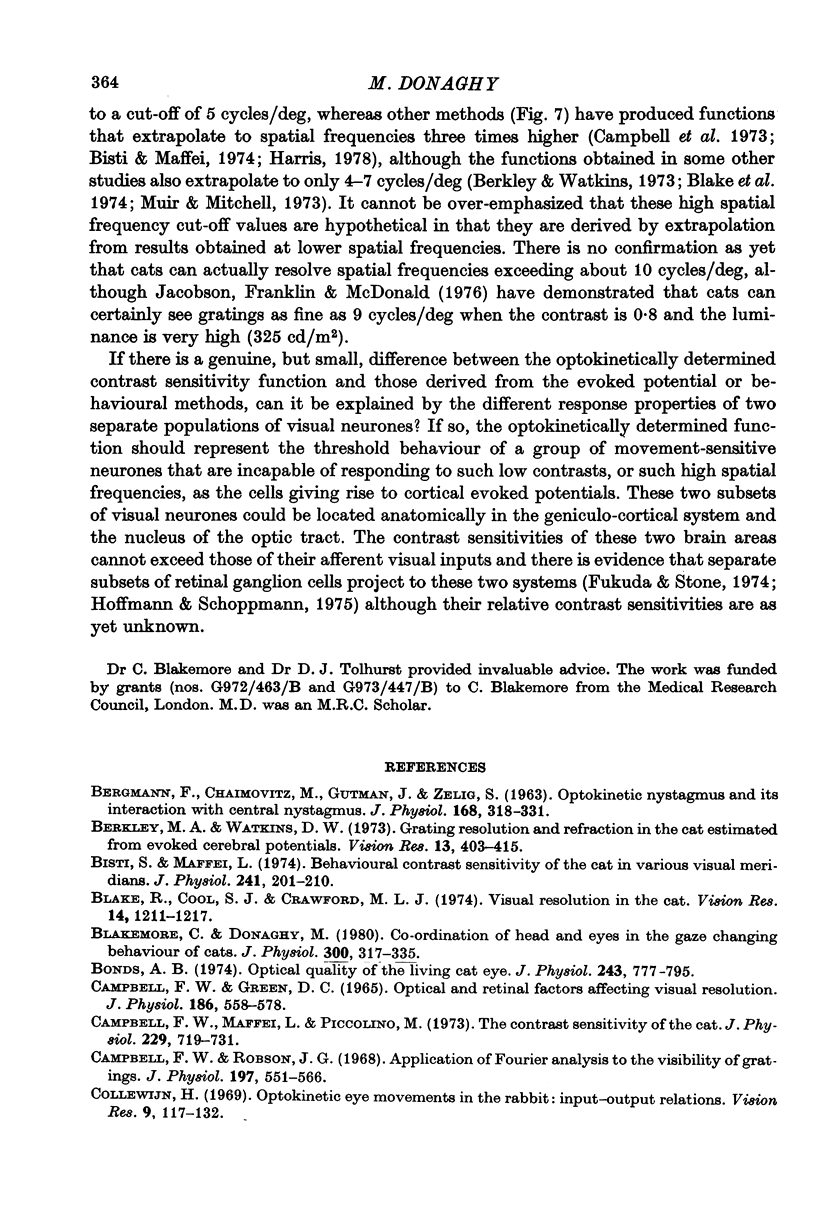
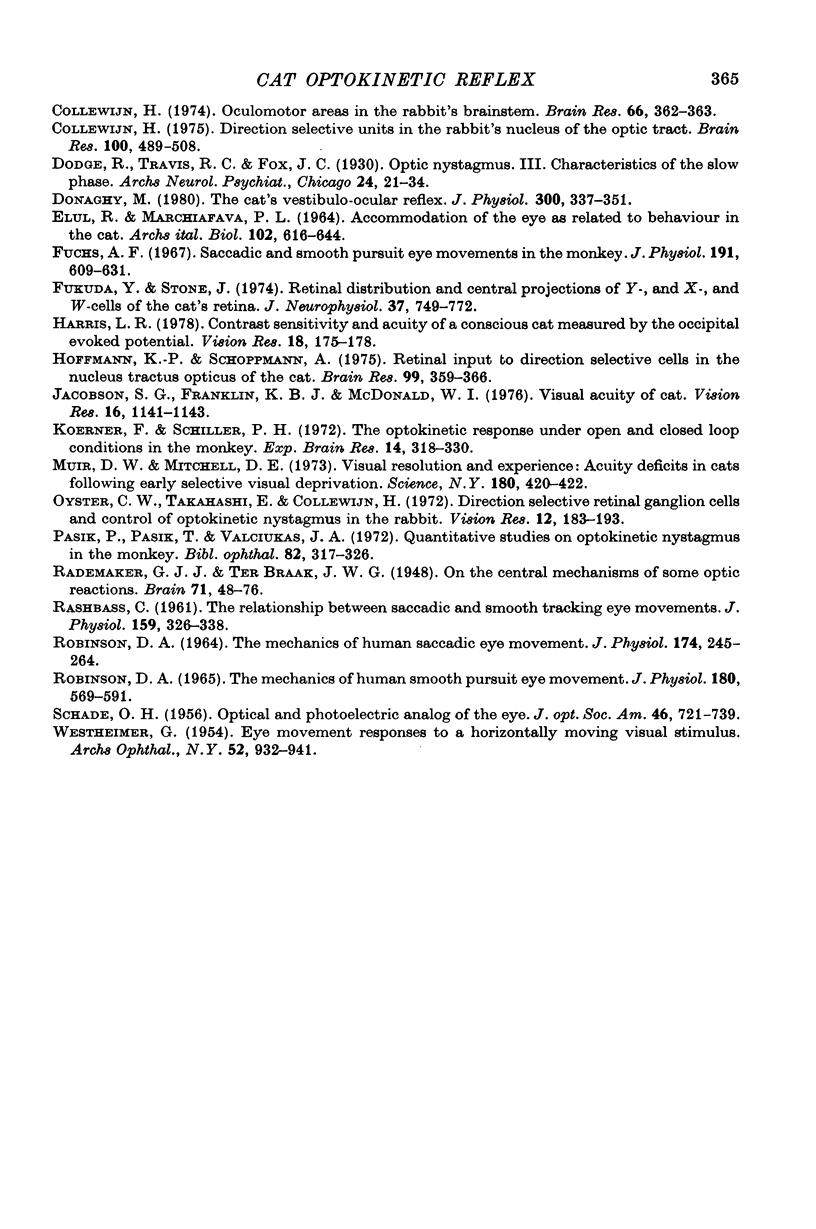
Selected References
These references are in PubMed. This may not be the complete list of references from this article.
- BERGMANN F., CHAIMOVITZ M., GUTMAN J., ZELIG S. OPTOKINETIC NYSTAGMUS AND ITS INTERACTION WITH CENTRAL NYSTAGMUS. J Physiol. 1963 Sep;168:318–331. doi: 10.1113/jphysiol.1963.sp007194. [DOI] [PMC free article] [PubMed] [Google Scholar]
- Berkley M. A., Watkins D. W. Grating resolution and refraction in the cat estimated from evoked cerebral potentials. Vision Res. 1973 Feb;13(2):403–415. doi: 10.1016/0042-6989(73)90117-x. [DOI] [PubMed] [Google Scholar]
- Bisti S., Maffei L. Behavioural contrast sensitivity of the cat in various visual meridians. J Physiol. 1974 Aug;241(1):201–210. doi: 10.1113/jphysiol.1974.sp010649. [DOI] [PMC free article] [PubMed] [Google Scholar]
- Blake R., Cool S. J., Crawford M. L. Visual resolution in the cat. Vision Res. 1974 Nov;14(11):1211–1217. doi: 10.1016/0042-6989(74)90218-1. [DOI] [PubMed] [Google Scholar]
- Blakemore C., Donaghy M. Co-ordination of head and eyes in the gaze changing behaviour of cats. J Physiol. 1980 Mar;300:317–335. doi: 10.1113/jphysiol.1980.sp013164. [DOI] [PMC free article] [PubMed] [Google Scholar]
- Bonds A. B. Optical quality of the living cat eye. J Physiol. 1974 Dec;243(3):777–795. doi: 10.1113/jphysiol.1974.sp010777. [DOI] [PMC free article] [PubMed] [Google Scholar]
- Campbell F. W., Gubisch R. W. Optical quality of the human eye. J Physiol. 1966 Oct;186(3):558–578. doi: 10.1113/jphysiol.1966.sp008056. [DOI] [PMC free article] [PubMed] [Google Scholar]
- Campbell F. W., Maffei L., Piccolino M. The contrast sensitivity of the cat. J Physiol. 1973 Mar;229(3):719–731. doi: 10.1113/jphysiol.1973.sp010163. [DOI] [PMC free article] [PubMed] [Google Scholar]
- Campbell F. W., Robson J. G. Application of Fourier analysis to the visibility of gratings. J Physiol. 1968 Aug;197(3):551–566. doi: 10.1113/jphysiol.1968.sp008574. [DOI] [PMC free article] [PubMed] [Google Scholar]
- Collewijn H. Direction-selective units in the rabbit's nucleus of the optic tract. Brain Res. 1975 Dec 26;100(3):489–508. doi: 10.1016/0006-8993(75)90154-7. [DOI] [PubMed] [Google Scholar]
- Collewijn H. Optokinetic eye movements in the rabbit: input-output relations. Vision Res. 1969 Jan;9(1):117–132. doi: 10.1016/0042-6989(69)90035-2. [DOI] [PubMed] [Google Scholar]
- Donaghy M. The cat's vestibulo-ocular reflex. J Physiol. 1980 Mar;300:337–351. doi: 10.1113/jphysiol.1980.sp013165. [DOI] [PMC free article] [PubMed] [Google Scholar]
- ELUL R., MARCHIAFAVA P. L. ACCOMODATION OF THE EYE AS RELATED TO BEHAVIOR IN THE CAT. Arch Ital Biol. 1964 Nov 10;102:616–644. [PubMed] [Google Scholar]
- Fuchs A. F. Saccadic and smooth pursuit eye movements in the monkey. J Physiol. 1967 Aug;191(3):609–631. doi: 10.1113/jphysiol.1967.sp008271. [DOI] [PMC free article] [PubMed] [Google Scholar]
- Fukuda Y., Stone J. Retinal distribution and central projections of Y-, X-, and W-cells of the cat's retina. J Neurophysiol. 1974 Jul;37(4):749–772. doi: 10.1152/jn.1974.37.4.749. [DOI] [PubMed] [Google Scholar]
- Harris L. R. Contrast sensitivity and acuity of a conscious cat measured by the occipital evoked potential. Vision Res. 1978;18(2):175–178. doi: 10.1016/0042-6989(78)90182-7. [DOI] [PubMed] [Google Scholar]
- Hoffmann K. P., Schoppmann A. Retinal input to direction selective cells in the nucleus tractus opticus of the cat. Brain Res. 1975 Dec 5;99(2):359–366. doi: 10.1016/0006-8993(75)90037-2. [DOI] [PubMed] [Google Scholar]
- Jacobson S. G., Franklin K. B., McDonald W. I. Visual acuity of the cat. Vision Res. 1976;16(10):1141–1143. doi: 10.1016/0042-6989(76)90254-6. [DOI] [PubMed] [Google Scholar]
- Koerner F., Schiller P. H. The optokinetic response under open and closed loop conditions in the monkey. Exp Brain Res. 1972;14(3):318–330. doi: 10.1007/BF00816166. [DOI] [PubMed] [Google Scholar]
- Muir D. W., Mitchell D. E. Visual resolution and experience: acuity deficits in cats following early selective visual deprivation. Science. 1973 Apr 27;180(4084):420–422. doi: 10.1126/science.180.4084.420. [DOI] [PubMed] [Google Scholar]
- Oyster C. W., Takahashi E., Collewijn H. Direction-selective retinal ganglion cells and control of optokinetic nystagmus in the rabbit. Vision Res. 1972 Feb;12(2):183–193. doi: 10.1016/0042-6989(72)90110-1. [DOI] [PubMed] [Google Scholar]
- Pasik P., Pasik T., Valciukas J. A. Quantitative studies on optokinetic nystagmus in the monkey. Bibl Ophthalmol. 1972;82:317–326. [PubMed] [Google Scholar]
- RASHBASS C. The relationship between saccadic and smooth tracking eye movements. J Physiol. 1961 Dec;159:326–338. doi: 10.1113/jphysiol.1961.sp006811. [DOI] [PMC free article] [PubMed] [Google Scholar]
- ROBINSON D. A. THE MECHANICS OF HUMAN SACCADIC EYE MOVEMENT. J Physiol. 1964 Nov;174:245–264. doi: 10.1113/jphysiol.1964.sp007485. [DOI] [PMC free article] [PubMed] [Google Scholar]
- Robinson D. A. The mechanics of human smooth pursuit eye movement. J Physiol. 1965 Oct;180(3):569–591. doi: 10.1113/jphysiol.1965.sp007718. [DOI] [PMC free article] [PubMed] [Google Scholar]
- SCHADE O. H., Sr Optical and photoelectric analog of the eye. J Opt Soc Am. 1956 Sep;46(9):721–739. doi: 10.1364/josa.46.000721. [DOI] [PubMed] [Google Scholar]
- WESTHEIMER G. Eye movement responses to a horizontally moving visual stimulus. AMA Arch Ophthalmol. 1954 Dec;52(6):932–941. doi: 10.1001/archopht.1954.00920050938013. [DOI] [PubMed] [Google Scholar]


